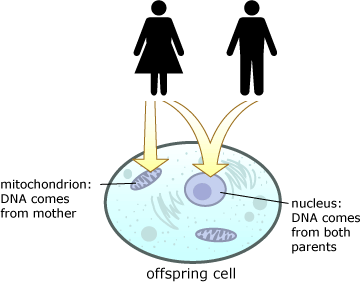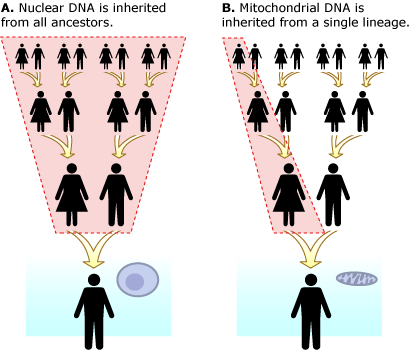
If you’ve ever sat down with a great aunt to reconstruct your family history, wondered if you might be related to Genghis Khan, or tried to calculate what portion of your genes come from that rowdy great-grandparent that your dad never wants to talk about, you might be tempted to try out the latest in genealogy research: DNA. Last month saw the launch of GeneTree.com, a business combining social networking with genetic testing. For a fee, GeneTree will use the DNA in a sample of your cheek cells (collected with a special mouthwash) to “discover your deepest ancestral roots.” With advances in DNA technology, some genetic tests are relatively easy to perform, and GeneTree joins more than 20 other companies aiming to unravel ancestry via DNA tests. But what are the limits of these tests? An evolutionary perspective helps reveal whether these companies can deliver on their promises.
Where's the evolution?
The tests used by ancestry businesses are based on human genetic variation. At a genetic level, people from all over the world are remarkably similar — 99.9% identical, in fact. But that one one-thousandth of our genome that does vary from person to person contains clues to our evolutionary history. It works like this. Anatomically modern humans evolved in Africa more than 100,000 years ago. Around 60,000 years ago, human populations began to migrate within and out of Africa, eventually colonizing the rest of the world. During this process, people in different migratory groups randomly acquired different mutations in their genomes and passed them on to their descendents. As those descendents moved into new areas or joined other groups of humans in different places, they carried these marker mutations with them.
Today, humans live in a fast-paced, global world — cell phone signals and airplanes zip from continent to continent — but our genomes still lug around the genetic souvenirs they picked up during the slower-paced migrations of our recent evolutionary history. Many of these mutations don’t seem to do anything in particular, but they can be used by scientists to reconstruct parts of our history. It’s a bit like sifting through the glove compartment of a car and finding a toll receipt from New Jersey and a napkin from a Vermont diner. Through such randomly acquired clues, we can begin to reconstruct possible stops on the car’s (and our own) recent journeys.
This is where genetic ancestry companies come in. They have collected DNA from people all over the world to get a feel for what marker mutations characterize different populations. When a customer sends in a DNA sample for analysis, the company tries to match that person’s genetic markers with those from people elsewhere in the world. Matches suggest that the person has ancestors from that population or shares recent common ancestors with the people of that population. The idea behind the tests is simple, but not foolproof.
One of the biggest drawbacks of such tests is that they usually analyze only a tiny amount of DNA. Many use mitochondrial DNA, which makes up less than .001% of our DNA. Unlike the rest of our genetic material, mitochondrial DNA is found, not in the nucleus, but in the mitochondria — those “powerhouse” organelles you might remember from biology class. Mitochondria are passed from mother to child — so, although the genes in the nuclei of your cells (your nuclear genes) come from both parents, your mitochondrial genes are a genetic gift from your mother alone. This clear pattern of inheritance — mitochondria’s single line of descent — eases genealogy research, but considered alone, can lead to oversimplification.
Here’s the problem. The bulk of our DNA is a mix inherited from both our biological mothers and biological fathers, whose DNA is, in turn, a mix from their own parents — your grandparents. For each generation back that you trace your genealogy, you’ll find twice as many ancestors: you have two parents, four grandparents, eight great-grandparents, sixteen great-great-grandparents, and so on. Your nuclear genes are a motley patchwork inherited from all those different ancestors (shown in A below). Your mitochondrial genes, on the other hand, were inherited directly from your mother’s mother’s mother’s mother’s mother’s…mother (shown in B below) and represent the genetic inheritance of single ancestral lineage. So if a genetic ancestry company were to trace your mitochondrial mutations to the high plains of Central Asia, for example, you’d have learned something about the migratory path of your mitochondrial ancestors, but nothing about your hundreds of other ancestors. Mitochondrial DNA is a useful, but far from comprehensive, resource for genealogy.
This caveat regarding mitochondrial DNA also highlights a common misconception about human evolutionary history. Biologists have sequenced mitochondrial DNA from people all over the world. Though the sequences vary somewhat due to the chance mutations described above, they are clearly related. Working backwards to reconstruct the history of all these mitochondrial sequences, biologists have figured out that they all descended from a mitochondrion in a woman who lived 100,000-200,000 years ago, called “mitochondrial Eve.” So far, so good. However, perhaps because of her biblical namesake, mitchondrial Eve is often misconstrued as the first woman, the only woman alive at her time, or the sole mother of all humanity. Though mitochondrial Eve did exist, she was none of those things. True, all humans on Earth today can count mitochondrial Eve among their great-great-great-great-great-(fill in roughly 5000 “greats”)-grandmas and inherited their mitochondrial DNA from her. But we have other great-great-great-great-great-(fill in 5000 “greats”)-grandmas as well who lived at the same time as mitochondrial Eve — you can think of them as our nuclear great-great-great-(etc.)-grandmas. We inherited other bits of our nuclear DNA from them — and from all of our equally ancient grandpas. Mitochondrial Eve is only one of our many human ancestors.
Just as mitochondrial Eve represents a single ancestor among many, mitochondrial DNA tests trace a single ancestral lineage among many. This is not to say that genetic ancestry tests can’t be informative or even change your view of yourself and the human species. Anyone who cares to delve into their own evolutionary history will find that all roads eventually lead to Africa, the continent on which the first human population evolved. While all of humanity is united by this common starting point, the paths taken by each of our ancestors afterwards are unique and have shaped the genetic inheritance passed on to each of us. Our mitochondrial lineage represents only one of these ancestral paths; nevertheless, glimpsing the hundred-thousand year long journey embarked upon by this chain of mothers is awe-inspiring and directly connects us — even if by a single genetic thread — to the origin of all humanity.
Primary literature:
- Bolnick, D. A., Fullwiley, D., Duster, T., Cooper, R. S., Fujimura, J. H., Kahn, J., Kaufman, J. S., Marks, J., Morning, A., Nelson, A., Ossorio, P., Reardon, J., Reverby, S. M., and Tallbear, K. (2007). The science and business of genetic ancestry testing. Science 318(5849):399-400. Read it »
- Weiss, K.M., and Long, J.C. (2009). Non-Darwinian estimation: My ancestors, my genes' ancestors. Genome Research 19(5):703-710. Read it »
News articles:
- An article on genetic ancestry websites from Reuters
- A review of some problems with genetic ancestry testing from Science Daily
- A description of scientific investigations related to mitochondrial Eve from NOVA
- An interactive website allowing explorations of ancestral human migration patterns from National Geographic
- An article on the genetic connections among organisms from the Tree of Life project
Understanding Evolution resources:
- What is genetic variation? Provide a hypothetical example of genetic variation in terms of you and your classmates.
- Read our tutorial on mutation. What is a mutation? Describe the possible effects a mutation might have on the individual who carries it.
- How is the process of mutation related to genetic variation?
- Consider an imaginary classmate, Alfred. Alfred’s biological mother and her ancestors came from Sweden, and Alfred’s biological father and his ancestors came from Korea. If Alfred has his mitochondrial DNA analyzed, what sort of marker mutations is he likely to find? If Alfred has his nuclear DNA analyzed, what sort of marker mutations is he likely to find?
- Human males inherit their Y chromosomes from their father alone. Imagine that one of your classmates, Fred, has his DNA analyzed by a genetic ancestry company. The company tells him that his Y-chromosome test places his ancestors in Western Europe. Fred is confused because he knows that at least one of his grandparents came from Northern India. How would you help explain Fred’s test results to him?
- Explore Atlas of the Human Journey on the Genographic Project website. According to the genetic evidence, by what route did the first humans to leave Africa travel? According to the genetic evidence, how did the first Americans get to North and South America? From what populations did they inherit their mitochondrial DNA?
- Teach about human genetic variation: In this lesson for grades 9-12, students conduct a classwide inventory of human traits, construct histograms of the data they collect, and play a brief game that introduces students to major concepts related to human genetic variation and the notion of each individual's uniqueness.
- Teach about evolution in mitochondrial genes: In this interactive web activity for grades 9-12, students compare the number of mutations in human and Neandertal mitochondrial genomes to determine ancestry and relatedness.
- Teach about prehuman migration: In this activity for grades 9-12, students plot the distribution of major hominid taxa on a world map to hypothesize about the origin and movement of prehuman ancestors.
- Baertlein, L. (2007, October 23). Wondering who you are? New site wants to tell you. Reuters. Retrieved October 31, 2007, from Reuters
- Bolnick, D. A., Fullwiley, D., Duster, T., Cooper, R. S., Fujimura, J. H., Kahn, J., Kaufman, J. S., Marks, J., Morning, A., Nelson, A., Ossorio, P., Reardon, J., Reverby, S. M., and Tallbear, K. (2007). The science and business of genetic ancestry testing. Science 318(5849):399-400.
- Human Genome Project Information (2006). Frequently asked questions. Retrieved October 31, 2007 from Human Genome Project
- National Human Genome Research Institute. (2005). International consortium completes map of human genetic variation. NIH News. Retrieved October 31, 2007 from National Human Genome Research Institute


